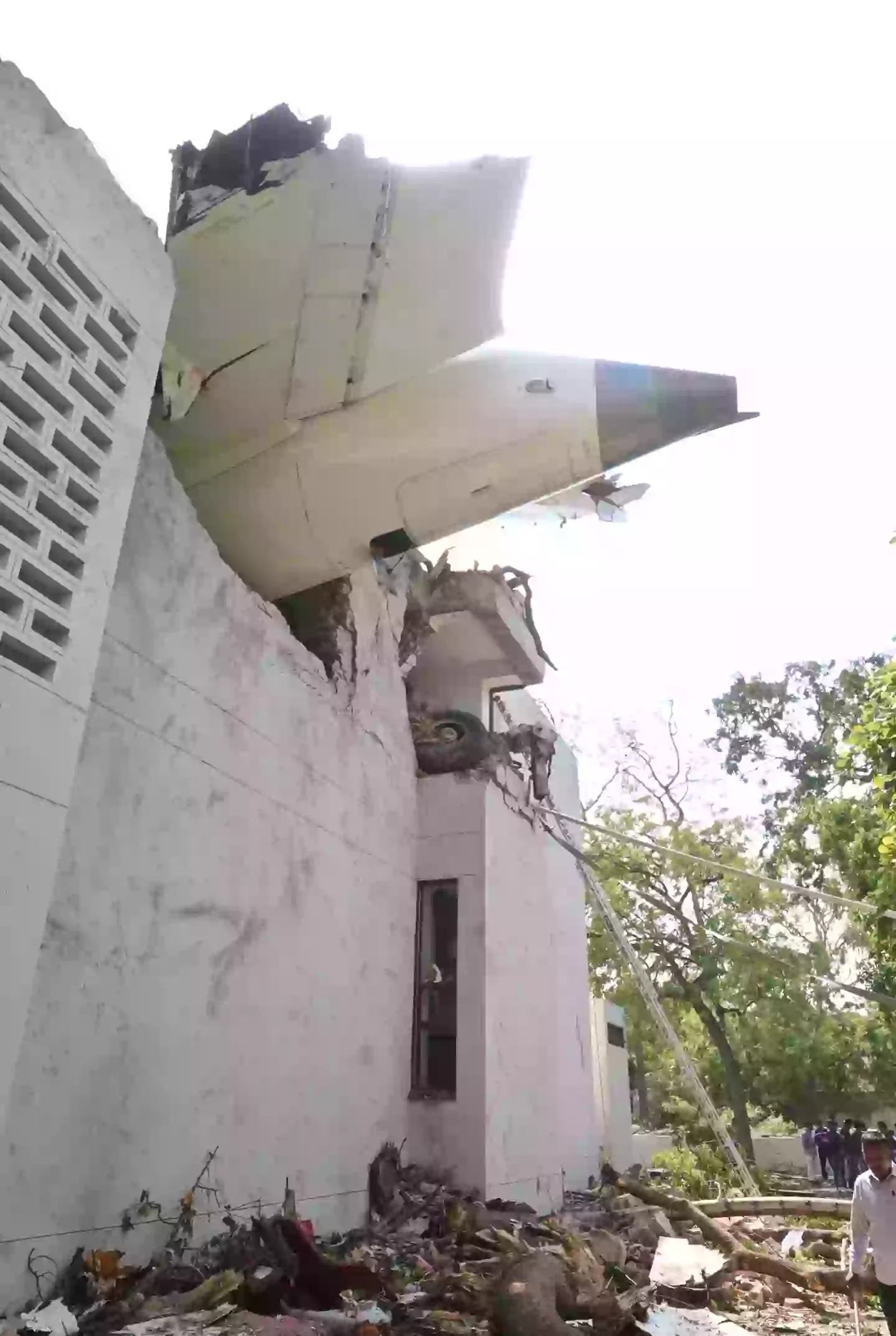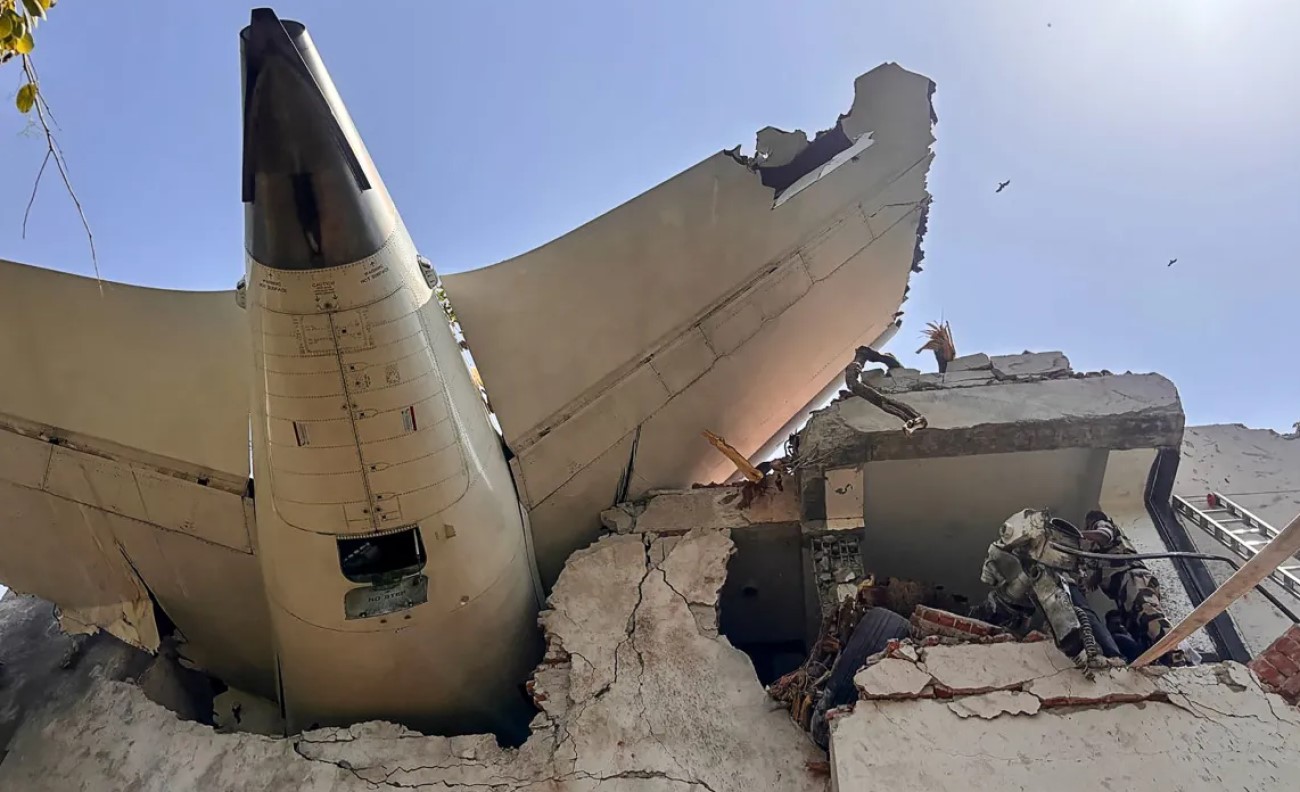In what has become one of the most devastating aviation disasters in recent memory, an Air India flight bound for London crashed shortly after takeoff from Ahmedabad, India, leaving hundreds dead and a nation in mourning. Against overwhelming odds, authorities have confirmed that one passenger miraculously survived the catastrophic crash that claimed the lives of nearly everyone aboard.
The Tragedy Unfolds
Air India Flight 171, carrying 242 people including passengers and crew, crashed into a residential area called Meghani Nagar shortly after departing from Ahmedabad’s Sardar Vallabhbhai Patel International Airport on Thursday afternoon. The Boeing 787-8 Dreamliner was bound for London Gatwick Airport and was expected to arrive at 6:25 PM local time this evening.
The aircraft took off at 1:38 PM local time (13:38 IST) and crashed just minutes later, making this the first fatal crash involving a Boeing 787 Dreamliner since the aircraft’s introduction in 2011. The tragedy marks Air India’s first major hull loss since the bombing of Air India Flight 182 in 1985.
A Single Survivor’s Harrowing Account
Ahmedabad Police Commissioner G.S. Malik confirmed that one survivor has been found – a British-Indian man named Vishwash Kumar Ramesh, who was seated in 11A. His survival story is nothing short of miraculous, given the devastating impact and subsequent fire that consumed much of the aircraft.
Speaking to The Hindustan Times from his hospital bed, Ramesh recounted the terrifying moments: “Thirty seconds after take-off, there was a loud noise and then the plane crashed. It all happened so quickly”. His account provides crucial insight into the final moments of the flight.
“When I got up, there were bodies all around me. I was scared. I stood up and ran. There were pieces of the plane all around me. Someone grabbed hold of me and put me in an ambulance and brought me to the hospital,” Ramesh told local media. The survivor revealed that his brother Ajay was also on board the flight but was seated in a different row, and he has been desperately seeking information about his sibling’s fate.
NBC News confirmed that Ramesh’s name and seat number match the flight manifest, and his family has confirmed to Sky News that he survived, though they haven’t heard from another family member believed to be on the plane.

The plane crashed a short while after takeoff (Stringer/Anadolu via Getty Images)
Devastating Loss of Life
Local police chief G.S. Malik confirmed that 204 bodies have been recovered from the crash site, though this number is expected to rise as rescue operations continue. State police officer Vidhi Chaudhary told Reuters that approximately 294 people have died, including passengers, crew members, and people on the ground.
The high death toll is partly due to the aircraft crashing into a densely populated residential area during the lunch hour. The plane, or parts of it, smashed into the cafeteria of B.J. Medical College in Ahmedabad, where medical students were having their lunch break. This tragic timing significantly increased the casualties beyond those aboard the aircraft.
India’s Federation of All India Medical Association (FAIMA) reported that 50 medical students had been admitted to the hospital, with at least four students missing and at least two in critical condition. One mother, Ramila, told ANI that her son had jumped from the second floor of the hostel building to escape, suffering injuries but surviving.
International Passengers and Crew
The flight was carrying 230 passengers and 12 crew members from multiple nationalities. According to Air India’s manifest, the passengers included 169 Indian nationals, 53 British nationals, seven Portuguese nationals, and one Canadian. This international composition has prompted responses from multiple governments, including the United Kingdom, where many families anxiously await news of their loved ones.
Among the confirmed victims was Vijay Rupani, the former chief minister of Gujarat state, of which Ahmedabad is the main city. Relatives have been asked to provide DNA samples to identify the dead due to the severe nature of the impact and subsequent fire.
The Aircraft and Technical Details
The aircraft involved was an eleven-year-old Boeing 787-8 Dreamliner registered as VT-ANB, which was delivered to Air India in January 2014 and powered by General Electric GEnx-1B67 engines. According to aviation data firm Cirium, the more than 11-year-old plane had 41,000 hours of flight time and nearly 8,000 takeoffs, which are average for that aircraft and year of manufacture.
Initial flight-path data from Flightradar24 shows that the aircraft reached a maximum barometric altitude of 625 feet (airport altitude is about 200 feet) and then began to descend with a vertical speed of -475 feet per minute. The ADS-B transponder reported an altitude of 625 feet before reception was lost at around 230 feet before the threshold of runway 05.
India’s aviation regulatory body confirmed that the aircraft gave a mayday call, signaling an emergency, but then did not respond to subsequent calls from airport traffic control. This suggests the crew was aware of a serious problem but were unable to continue communication, likely due to the rapid deterioration of the situation.
The Crash Scene and Emergency Response
Video verified by The Associated Press showed the jet slowly descending as if it were landing, but as soon as it disappeared behind rows of houses, a giant fireball filled the sky. Footage shared on social media showed debris on fire with huge plumes of thick, black smoke rising into the sky near the airport.
Firefighters doused the smoking wreckage with water, as the plane would have been fully loaded with fuel shortly after takeoff. Charred bodies lay on the ground and parts of the fuselage were scattered around the site. The tail of the plane was stuck on top of the building it crashed into.
Indian army teams were assisting civil authorities to clear debris and help treat the injured. The Central Industrial Security Force (CISF), responsible for security at Ahmedabad Airport, was among the first responders. All flight operations at Ahmedabad Airport were temporarily suspended following the crash.
Government and Official Response
Prime Minister Narendra Modi, whose home state is Gujarat, wrote on X: “The tragedy in Ahmedabad has stunned and saddened us. It is heartbreaking beyond words. In this sad hour, my thoughts are with everyone affected by it”. Modi directed the Ministry of Civil Aviation to take “all possible action” to assist at the crash site.
Indian Home Minister Amit Shah reportedly spoke with the Chief Minister of Gujarat, Bhupendra Patel, following the incident. The government has mobilized all available resources for rescue and recovery operations.
International Reactions and Support
King Charles III and Queen Camilla expressed being “desperately shocked” by the crash. The King said in a message: “Our special prayers and deepest possible sympathy are with the families and friends of all those affected by this appallingly tragic incident across so many nations, as they await news of their loved ones”.
Britain was working with Indian authorities to urgently establish the facts around the crash and provide support to those involved. Britain has very close ties with India, with nearly 1.9 million people of Indian descent according to the 2021 U.K. census.
U.S. President Donald Trump told reporters at the White House: “The plane crash was terrible… it was a horrific crash,” and offered American assistance, saying “anything we can do, we’ll be over there immediately”.
Aviation Industry Impact
This marks the first crash of a Boeing 787 Dreamliner according to the Aviation Safety Network database, dealing a significant blow to Boeing’s reputation as the company continues to recover from previous safety issues. Boeing’s stock futures prices sank almost 9% following the crash.
Boeing issued a statement saying: “We are in contact with Air India regarding Flight 171 and stand ready to support them. Our thoughts are with the passengers, crew, first responders and all affected”. GE Aerospace, which manufactured the engines, extended “heartfelt sympathies to the families and loved ones of those impacted” and activated their emergency response team.
Investigation Efforts
The Directorate General of Civil Aviation (DGCA) and Air India have both launched investigations into the crash, with a technical team dispatched to assess the cause. The U.S. National Transportation Safety Board said it would lead a team of U.S. investigators traveling to India to help in the investigation.
Aviation consultant John M. Cox noted that while early images were poor, it appeared the aircraft had its nose up and was not climbing, which would be a key focus for investigators. The cause of the crash wasn’t immediately known and could take months to determine through comprehensive investigation.
Air India’s Response and Compensation
Air India CEO Campbell Wilson released a video message expressing the airline’s commitment to supporting affected families. “This is a difficult day for all of us at Air India and our efforts now are focused entirely on the needs of our passengers, crew members, their families and loved ones”.
Tata Group, the parent company of Air India, has offered 10,000,000 Indian rupees (~US$116,855) compensation per person to the families of victims. The airline has also committed to covering medical expenses for those injured and has activated an emergency center with support teams for families.
Historical Context and Aviation Safety
The last major passenger plane crash in India was in 2020, when an Air India Express Boeing-737 skidded off a hilltop runway in southern India, killing 21 people. The worst air disaster in India was on November 12, 1996, when a Saudi Arabian Airlines flight collided midair with a Kazakhstan Airlines flight near Charki Dadri, killing all 349 people on board both planes.
The crash comes days before the opening of the Paris Air Show, a major aviation expo where Boeing and Airbus showcase their aircraft. Boeing has been in recovery mode for more than six years following previous incidents with the 737 Max.
Looking Forward: Questions and Implications
This devastating crash raises numerous questions about aviation safety, emergency response procedures, and the resilience of modern aircraft design. The sole survivor’s account will be crucial for investigators trying to understand what went wrong in those critical seconds after takeoff.
The tragedy serves as a stark reminder of the inherent risks in aviation, despite the industry’s generally excellent safety record. For the families of the 241 people who didn’t survive, and for the lone survivor grappling with the trauma of his experience, the path forward will be long and difficult.
As investigations continue and the aviation community grapples with the first-ever fatal crash of a Boeing 787 Dreamliner, this incident will undoubtedly lead to renewed scrutiny of aircraft safety systems, crew training procedures, and emergency response protocols. The priority now remains on supporting the survivors, caring for the injured, and providing closure for the families of those lost in this tragic accident.
The story of Vishwash Kumar Ramesh’s survival against impossible odds provides a small beacon of hope in this overwhelming tragedy, while the broader investigation will help ensure that lessons learned from this disaster contribute to preventing future aviation accidents.

